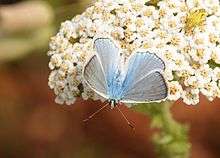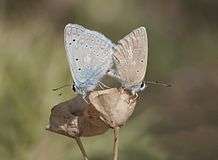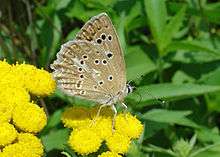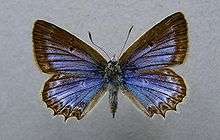Polyommatus daphnis
Polyommatus daphnis, the Meleager's blue, is a butterfly of the family Lycaenidae.
| Polyommatus daphnis | |
|---|---|
 | |
| Male, upperface | |
| Male, underface | |
| Scientific classification | |
| Kingdom: | Animalia |
| Phylum: | Arthropoda |
| Class: | Insecta |
| Order: | Lepidoptera |
| Family: | Lycaenidae |
| Genus: | Polyommatus |
| Species: | P. daphnis |
| Binomial name | |
| Polyommatus daphnis | |
| Synonyms | |
Subspecies
Subspecies include:[3]
Distribution
This species can be found in Eastern and Southern Europe and Western Asia, ranging from Southern Poland to the Balkans, Lebanon, Syria, Iran, Southern Urals, Turkey, Caucasus and Transcaucasia.[1][3]
Habitat
These butterflies inhabit grassy and bushy areas, clearings in scrubland and open flowery meadows in hills, at an elevation of 200–1,700 metres (660–5,580 ft) above sea level.[4][5]
Description
Polyommatus daphnis has a wingspan of 36–38 millimetres (1.4–1.5 in).[4] These small butterflies present a sexual dimorphism. The upperside of the wings is bright blue in males, while in the females it is usually blue bordered with dark brown. The underside of the wings tends to be pale ocher in the females and grey-bluish in the males, with black spots surrounded by white. The hindwings are distinctly scalloped, especially in the females.[4][5]
Description in Seitz
L. meleager Esp. (= daphnis Bgstr., female = endymion Schiff.) (81 a). male very large and very light sky-blue, strongly glossy, with a very narrow black margin. Underside pale grey-brown, with the base dusted with blue, the ocelli but little prominent and those near the margin of the hindwing very weak.Female at once recognized by the dentate anal portion of the outer margin. From Central and South Germany, Switzerland and South France throughout South-East Europe and Asia Minor to Syria and Kurdistan. — ab. limbopunctata Schulz are males with black marginal spots on the upperside. ab. steeveni Trk. (81 a) are strongly darkened females, which have a very wide distribution among ordinary specimens, but are more frequently found in the East, in Greece, Asia Minor, etc. — versicolor Ruhl-Heyne is a form from Mesopotamia with the upperside very light blue and the marginal spots of the underside entirely obsolete. — ignorata Stgr. [= P. d. versicolor (Rühl, 1895)](81 a), from Akbes in the south-western Taurus, is very peculiar as regards colour; the upperside of the female is traversed by many shadowy streaks situated on the veins; the hindwing of the male is likewise dentate in the anal portion, while in the female the teeth are so strong that they form 2—3 short tails. — Larva green with yellow swellings; spiracles black. Until June on Thymus, Orobus, Astragalus, and Coronilla. The butterflies in July and August; they are partial to limestone soil and occur singly in hot valleys, more in the hills and plains than in the mountains; on meadow-flowers, singly.[6]
Biology
It is a univoltine species. The butterflies fly from June to August.[4][5] The larvae feed on horseshoe vetch, sainfoin and Securigera varia. Larvae are attended by ants (Lasius alienus, Formica pratensis, Tapinoma eraticum).[3][7]
Gallery
 Mating pair
Mating pair.jpg) Female, upperface
Female, upperface Female, underface
Female, underface Mounted specimen, female
Mounted specimen, female
Bibliography
- LepIndex: The Global Lepidoptera Names Index. Beccaloni G.W., Scoble M.J., Robinson G.S. & Pitkin B.
- Tom Tolman et Richard Lewington, Guide des papillons d'Europe et d'Afrique du Nord, Delachaux et Niestlé, 1997 (ISBN 978-2-603-01649-7)
- Otakar Kudrna: The distribution atlas of European butterflies. In: oedippus. Band 20. Apollo Books, Stenstrup Danmark 2002, ISBN 87-88757-56-0, S. 258.
- Chris A. M. van Swaay & Martin S. Warren: Red Data Book of European Butterflies (Rhopalocera), Nature and Environment, No. 99, Council of Europe Publishing, Strasbourg, 1999
External links
References
- "Polyommatus (Meleageria) daphnis". Fauna Europaea.
- "Polyommatus daphnis". Inventaire National du Patrimoine Naturel. Archived from the original on 30 May 2018. Retrieved 27 June 2015. Taxonomie
- Funet
- Simon Coombes Captain's European Butterfly Guide
- Matt Rowlings Euro Butterflies
- Seitz, A. Seitz, A. ed. Band 1: Abt. 1, Die Großschmetterlinge des palaearktischen Faunengebietes, Die palaearktischen Tagfalter, 1909, 379 Seiten, mit 89 kolorierten Tafeln (3470 Figuren)

- Paolo Mazzei, Daniel Morel, Raniero Panfili Moths and Butterflies of Europe and North Africa
| Wikimedia Commons has media related to Polyommatus daphnis. |